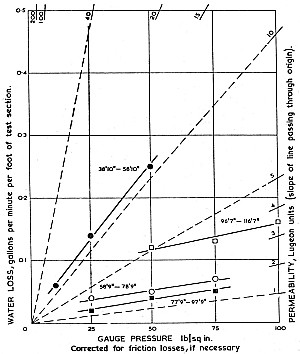DIAMOND DRILLING FOR FOUNDATION EXPLORATION-Moye
The results of water pressure tests are analysed by a graphical method (Fig. 3). For each test section in a particular hole the flow out of the hole in gal./min./ft. is plotted against gauge pressure in lb./sq.in. (corrected as necessary for friction losses). The results of the three tests usually fall approximately on a straight line, and the slope of this line defines the permeability of the rock (see Appendix).

Fig. 3.—Calculation of Permeability of Rock around Parts of Drill Hole 6022 from Water Pressure Tests—see also last column in Fig. 1.
Permeability is given in Lugeon units (Ref. 2) to keep in mind that we are dealing with jointed rock which is not necessarily heterogeneous and isotropic with respect to its permeability. However, if the material is assumed to be homogeneous and isotropic then 1 Lugeon is approximately equal to a permeability of 10 ft./year.
Other Tests in Drill Holes :
Several other tests can be made on drill holes after completion. For this reason drill holes are permanently preserved by leaving drill casing (or a cheaper substitute) in at least the top part of the hole and fitting a substantial cap.
Electric Logs.
—Electric logs are made on many holes with a single electrode, hand cranked "Widco" logger which gives curves for Resistivity and Self-Potential plotted against depth on the scale 1 in. = 10 ft. (the same scale as the Geological Log). In a uniform rock type like granite, weathered seams, faults and many joints show up prominently as sharp drops in resistivity on the resistivity curve.
Seismic Tests.
—Drill holes are useful for up-hole seismic shooting to determine seismic velocities for calibration of test data and interpretation of results from re ar seismic refraction surveys.
Temperature Logs.
—Rock temperature logs have been made on many drill holes, the information being used to predict rock temperatures in tunnels under high cover and in underground power stations.
Other Possible Tests.
—Many other useful types of tests on rock around drill holes are now feasible but have not been employed by the Authority. These include bore hole photography, bore hole inspection by closed circuit television, acoustic logging as used in the holes put down for petroleum exploration and measurement of rock modulus by in situ loading tests.
